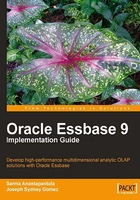
上QQ阅读APP看书,第一时间看更新
Conventions
In this book, you will find a number of styles of text that distinguish between different kinds of information. Here are some examples of these styles, and an explanation of their meaning.
Code words in text are shown as follows: "Note that the Time dimension contains the calendar periods used in the EssCar system"
A block of code will be set as follows:
[default]
IF (@ISMBR ("PRICE"))
"TOTAL NET REVENUE" ="TOTAL REVENUE" - "TOTAL DISCOUNTS";
ELSEIF (@ISMBR ("UNIT"))
"TOTAL NET REVENUE" = 0;
ENDIF
When we wish to draw your attention to a particular part of a code block, the relevant lines or items will be shown in bold:
[default]
[Thu Sep 11 00:40:45 2008]Local/ESSBASE0///Info(1051061)
Application Demo loaded - connection established
[Thu Sep 11 00:40:45 2008]Local/ESSBASE0///Info(1054027) Application [Demo] started with process id [4744]
[Thu Sep 11 00:40:45 2008]Local/ESSBASE0///Info(1056090)
Any command-line input or output is written as follows:
ESSCMD C:\Batch.SCR
New terms and important words are shown in bold. Words that you see on the screen, in menus or dialog boxes for example, appear in our text like this: "clicking the Next button moves you to the next screen".